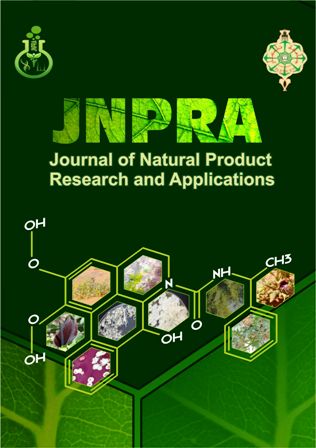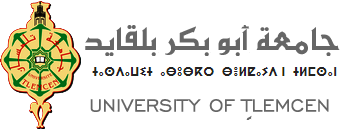Effect of Citrullus colocynthis oil on the lipid profile of obese male rats
DOI:
https://doi.org/10.46325/jnpra.v4i02.74Keywords:
Obesity; hepatic steatosis: colocynth oil; liver; PUFAs.Abstract
Citrullus colocynthis is a plant of the cucurbitaceae family native to arid soils. It contains around 17℅ of oil, rich in essential polyunsaturated fatty acids with regulatory powers for certain metabolic pathologies such as hypercholesterolemia. The aim of this work is to test the effect of colocynth oil (CO) on hepatic lipids in Wistar rats fed hyper-fatty diets supplemented with (CO), compared with other rats fed control diets based on 8 ℅ sunflower oil (SO). To this end, male Wistar rats weighing 80±5g were divided into four batches. The rats were fed different diets (R) for 2 months (D1: 16℅ casein + 8℅ SO, D2: 16℅ casein+ 8℅ CO, D3: 16℅ casein+ 30℅ fat+ 8℅ SO, D4: 16℅ casein+ 30℅ fat+ 8℅ CO), the weights of the rats and the quantity of food ingested were taken daily, at the end of the diet the rats were dissected and the livers recovered for hepatic lipid assays using the folch method. The results showed a reduction in triglycerides in the liver of rats fed diets containing oil of colocynth (37%) and reduced blood triglyceride (12%) and cholesterol (6%), whereas rats fed high-fat diets had elevated hepatic and blood lipid levels. Colocynth oil has a corrective and/or protective effect on obesity and its complications by preventing the accumulation of fat in the liver, thereby preventing hepatic steatosis.
References
Adam, S.E.I., Al-Yahia, M.A., & Al-Farhan, A. (2001). Combined Toxicity of Cassia sanna and citrullus colocynthis in rats. Vet. Humman. Toxicology, 43, 70-72. l
Ali Esmail, A. (2016). Chemical constituents and pharmacological effects of Citrullus colocynthis - A review. IOSR Journal of Pharmacy, 2319-4219.
Al-khalifa, A. S. (1996). Physicochemical characteristics, fatty acid composition, and lipoxygenase activity of crude pumpkin and melon seed oils. Journal of Agriculture and Food Chemistry, 44, 964-966.
Amal, B. (2006). Etude biochimique et nutritionnelle de l’effet immunomodulateur des huiles d’argan, de poison et d’olive. Effets compares de leurs acides gras. Thèse en cotutelle. ISAL-0031 ,73-74.
Boirie, Y. (2009). Obésité : physiopathologie et conséquences. Chapitre 16, SAMU de France.
Bray GA, Heisel WE, Afshin A, et al. (2018). The science of obesity management: and Endocrine Society scientific statement. Endocrine Reviews, 39 (2):79–132. doi:10.1210/er.2017-00253
Chan, P., Tomlinson, B., Lee, C.B., & Lee, Y.S. (1996). Effectiveness and safety of low-dose pravastation and squalène, alone and in combination, in elderly patients with hypercholesterolemia. Clinical Pharmacology 36, 422-427
Couet, C., Delarue, J., Ritz, P., Antoine, J. M., & Lamisse, F. (1997). Effect of dietary fish oil on body fat mass and basal fat oxydation in healthy adults. International Journal of Obesity, 21, 637-643.
Delplanque, B., Leroy, B., & Mendy, F. (2002). Equilibre entre acides gras saturés : contribution à l’étude de la prévention des maladies cardio-vasculaires. Oléagineux Corps Gras Lipides, 9, 237-243.
Dominique, H. (2010). Impact métabolique des acides gras saturés/insaturés. Innovations Agronomiques, 10, 11-23.
Folch, F., Lees, M. G. H., Sloane, & Stanley, G.H. (1957). A simple method for the isolation and purification of total lipides from animal tissues. Journal of Biological Chemistry, 226(1) ,497-509.
Imededdine, A.N., Hassen, S., Chin, P.T., & Saud, I.A. (2012). Evaluation and characterisation of Citrullus colocynthis (L.) Schrad seed oil: Comparison with Helianthus annuus (sunflower) seed oil. Food Chemistry, 136 (2013), 348–353.
Ruiz-Rodriguez A, Reglero G, & Ibanez E (2010). Recent trends in the Advanced analysis of bioactive fatty acids. Journal of Pharmaceutical and Biomedical Analysis, 51(2), 305-326.
Schafferman, D., Beharav, A., Shabelsky, E., & Yaniv, Z (1998). Evaluation of Citrullus colocynthis, a desert plant native in Israel, as a potential source of edible oil. Journal of Arid Environments, 40, 431–439.
Sebbagh, N., Chabane Sari, D., Taleb, S.A., Benyoucef, M., Lahouel, M., Ktorza, A., & Magnan, C. (2007). Effect of dietary colocynthis and sun flower fatty acids containing oils on lipids metabolism and on antioxidant stress parameters in streptozotocine-induced diabetics rats. Research Journal of Applied Sciences, 2, 832-838.
Sebbagh, N., Cruciani-Guglielmacci, C., Ouali, F., Berthault, M.F., Rouch, C., Chabane Sari, D., & Magnan, C. (2009). Comparative effects of Citrullus colocynthis, sunflower and olive oil-enriched diet in streptozotocin-induced diabetes in rats. Diabetes & Metabolism, (35), 178-184.
Shinji, I., Mayumi, T., Nobuyo, T., Kayo, M., Hiroshige, I., & Osamu, E. (1996). High-Fat Diet-Induced Hyperglycemia and Obesity in Mice: Differential Effects of Dietary Oils. Metabolism, 145,1539-1546.
Simopoulos, A.P. (2006). Evolutionary aspects of diet, the omega-6/omega-3 ratio and genetic variation: nutritional implications for chronic diseases. Journal of Biomedicine & Pharmacotherapy, 60(9),502-7.
Swantson- Flatt, S. K., Day, C., Bailey, C.J., & Flatt, P.R. (2004). Traditional plant treatements for diabetes. Studies in normal and streptozotocin diabetic mice. Diabitologia, 33, 462-464.
Tanaka, R.D., Aliau, S., & Edwards, P.A. (1983). Regulation of Hydroxy-Méthyl-Glutaryl-CoA réductase in avian myeloblasts: mode of action of hydroxycholesterol. Journal of Biological Chemistry, 258, 13331-13339.
Tomé Daniel. (1994). Des macro-nutriments alimentaires à la santé de l'homme. Institut national agronomique Paris-Crignon (INA-PG).
Van Marken Leichtenbelt, W.D, Mensinkrp, & Westerterp, K.R. (1997). The effect of fat composition of the diet on energy metabolism. Z Ernährungswiss, 36, 303-305
Walrand, S., Fisch, F., Bourre, J.M. (2010). Tous les acides gras saturés ont-ils le même effet métabolique ? Nutrition clinique et métabolisme, 24, 63-75
WHO (2024). Obésité et surpoids. http://www.who.int/fr/news-room/fact-cheets/detail/obesity -and-overweight.
Downloads
Published
Issue
Section
License

This work is licensed under a Creative Commons Attribution-NonCommercial 4.0 International License.






